According to a recent article, a pilot study shows that around 30% of patients with wet age-related macular degeneration might have the ability to stop their eye injection therapy safely without increasing vision loss.
Wet macular degeneration (wMD) is one of two forms of macular degeneration, and it is characterized by blurred vision or blind spots in one’s vision. The wet form is more rare than the dry form, but wMD always begins as dry macular degeneration.
Symptoms:
The onset of symptoms in this condition is sudden, and symptoms tend to progress quickly. Possible effects include:
- A hard time recognizing faces
- Visual distortions
- Trouble adjusting to low light
- Needing brighter light for activities like reading
- Reduced central vision
- Trouble reading due to the blurriness of printed words
- Colors seem less bright and intense
- Blurry spot within the field of vision
Wet AMD Treatment
In most cases, patients with wet AMD are treated with injections of anti-VEGF drugs into the eye monthly or every other month. Anti-VEGF drugs are drugs that block vascular endothelial growth factors. They work by slowing or stopping the production of leaky blood vessels in the eye. This then helps to stop the occurrence of more vision loss.
Although this treatment is effective for patients, it can be an inconvenience for them. They must travel to see their doctor every month or so to get these treatments, and this barrier leads many patients to skip treatments and thus their symptoms worsen.
The Study
Researchers at Johns Hopkins Medicine looked at 106 patients with wet age-related macular degeneration in this preliminary study. The patients in this study were ones who were treated for their AMD at the Johns Hopkins Wilmer Eye Institute between the years of 2013 and 2020.
The study worked by creating a customized anti-VEGF injection schedule for each patient involved in the study. The patients’ responses to the therapy were closely monitored to see if they needed an injection every time they visited their doctor or if it was possible to skip it. This was determined through if there was any new disease activity observed in the patient after pausing the treatment. For patients who went without treatment and had no indications of fluid build-up or further loss of vision after being monitored for 30 weeks, they were considered to be safely taken off of anti-VEGF therapy.
After one year, the results showed that around one-third of patients had halted their anti-VEGF treatments in a single eye at least. Some of the other patients still needed their injections every month, others were required to get injections less often, and a small percentage were able to be weaned off of their treatment after two years.
Furthermore, the patients who were able to be weaned off of injections after one year proved to have the most successful outcome out of the study. They had reduced amounts of fluid in their eye or eyes and they had improved vision compared to the other patients in the study.
Biomarkers
The study results led researchers to look into biomarkers that might be able to distinguish the patients who needed monthly injections and those who could go without.
Researchers used a little bit of fluid from the patient’s eyes that they had extracted before the study began to look at the differences. They also continued to collect samples during the patient’s clinic visits during the study. By doing so, they discovered that there were 172 proteins that patients had different amounts of and this was the difference between who could stop treatment and who could not.
The team furthered their research by studying one of the 172 proteins in-depth, apolipoprotein B100. The patients who were weaned off treatment had significantly higher levels of this protein compared to those who could not. In addition, the levels of apolipoprotein B100 were greater in people who never developed wet AMD. This discovery led researchers to hypothesize that this particular protein could possibly help protect against patients developing wet AMD.
Akrit Sodhi, M.D., Ph.D., from Johns Hopkins University School of Medicine and Wilmer Eye Institute, is hopeful that there are other proteins amongst the 172 that may be biomarkers to anticipate how a patient will respond to anti-VEGF therapies. Dr. Sodhi is hopeful new macular degeneration treatments can be created in the future using a few of the 172 proteins. For that to happen, though, there needs to be more randomized clinical trials of people diagnosed with wet macular degeneration.








